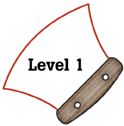
Alaska Science
Key Element D1
A student who meets the content standard should apply scientific knowledge and skills to understand issues and everyday events.
 |
Alaska Science A student who meets the content standard should apply scientific knowledge and skills to understand issues and everyday events. |
|
Performance Standard Level 1, Ages 5–7
|
|
|
|
Sample Assessment Ideas
|
|
|
Expanded Sample Assessment Idea
|
|
Procedure Students will:
Reflection and Revision
|
Levels of Performance |
||
|
Stage 4 |
Student work is complete, correct, and contains evidence of elaboration, extension, higher order thinking skills, and relevant knowledge. Student actively participates with group to perform an accurate test that considers several factors that may affect the distance traveled by the sled. | ||
|
Stage 3
|
Student work is generally complete and correct but may contain evidence of some inaccuracies or omissions. Student participates with group to perform an accurate test to determine the distance traveled by the sled. Multiple factors are not considered. | ||
|
Stage 2
|
Student work may be incomplete or inaccurate. Student may be a reluctant group participant. The test may include three types of sleds but does not control the variables or make accurate measurements. | ||
|
Stage 1
|
Student work is incomplete and inaccurate. Student does not participate in group task or participates in group sledding adventure rather than testing the sleds. | ||
Standards Cross-References
|
||
|
National Science Education Standards Use data to construct a reasonable explanation. This aspect of the standard emphasizes the students’ thinking as they use data to formulate explanations. Even at the earliest grade levels, students should learn what constitutes evidence and judge the merits or strengths of the data and information that will be used to make explanations. After students propose an explanation, they will appeal to the knowledge and evidence they obtained to support their explanations. Students should check their explanations against scientific knowledge, experiences, and observations of others. (Page 122) People have always had questions about their world. Science is one way of answering questions and explaining the natural world. (Page 138) Some objects occur in nature; others have been designed and made by people to solve human problems and enhance the quality of life. (Page 138) |
Benchmarks People can often learn about things around them just by observing those things carefully, but sometimes they can learn more by doing something to the things and noting what happens. (Page 10) |
|
Table of Contents | Return to Alaska Native Knowledge Network